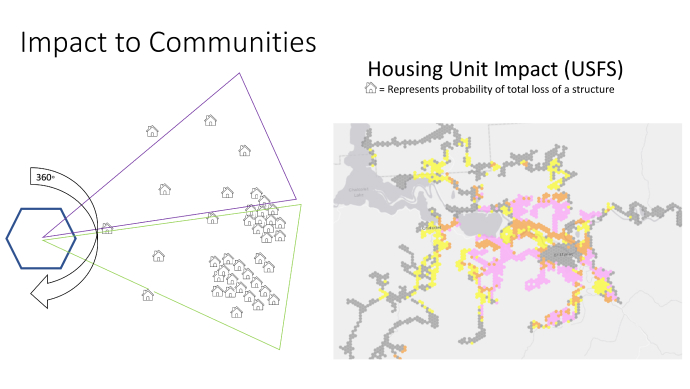Case study originally posted here.
Avista Utilities provides energy services to 411,000 electric and 377,000 natural gas customers across 30,000 square miles and four northwestern states. Avista’s history of innovation is rooted in hydroelectric energy, generated since the company’s founding in 1889. Recently, Avista was recognized for the fourth time by Ethisphere—a global leader in defining and advancing the standards of ethical business practices—as one of the world’s most ethical companies.
Challenge
Avista’s wildfire risk is threefold. One challenge is that wildfires are common throughout northeast Washington and northern Idaho, and as the population expands, many residents live in suburban areas next to forested lands. While many people envision Washington as living up to its nickname, the Evergreen State, areas east of Cascade Mountain receive much less rainfall than coastal areas do. Spokane receives an average of only 18 inches of rainfall per year. And climate change is making this situation worse, with more severe droughts combined with hotter summers. During most summers, wildfires cause damage to utility infrastructure, disrupting service to residents and sometimes prompting evacuations.
The second challenge comes from the broader utility community and regulators. In October 2018, residents in Paradise, California, suffered the most impactful wildfire in US history, destroying over 18,000 homes and causing 85 deaths. This galvanizing event prompted many utilities (including Avista) to develop a comprehensive wildfire resiliency plan.
The third challenge is change management. How would Avista leverage its 100-year history of responding to wildfires and create a risk-based plan that balanced wildfire risk against service costs and affordability for its customers?
Solution
Avista management established a wildfire study team to address these challenges. This team included project engineer Doug Forkner, who had experience using geographic information system (GIS) technology to monitor infrastructure health and quantify risk. He understood that Avista needed a geospatial approach to determining wildfire risk, appreciating both a short-term operating perspective and the inherent risk associated with overhead electric lines as fire ignition sources. Avista has a long history of GIS innovations and experience using Esri’s ArcGIS technology, so Forkner had an established platform to develop fire risk models.
Avista’s solution consisted of creating two things: a Wildland Urban Interface (WUI) model based on ArcGIS Pro and its model builder technology, and a weather-influenced model based on ArcGIS Experience Builder and ArcGIS Dashboards. The WUI algorithm created a series of risk hexagons overlaid on Avista’s electric facilities to quantify fire risk based on human development, burnable fuels, power outage rates, and the presence of vegetation near powerlines. In addition, the dynamic risk model helps Avista manage the system in real time by aligning system protection levels with fire ignition risk on each circuit in the service territory.
ArcGIS supports a variety of short- and long-term fire mitigation actions.
Results
The WUI model (figure below) indicates the probability and impact of utility-sourced fire ignition. To develop this model, Avista identified all overhead primary distribution conductor segments. Next, the GIS team segmented the infrastructure coverage into 250-meter hexagonal shapes. Finally, each hexagon was assigned a risk score and a color code. Risk scoring was based on five-year average system performance and other factors such as fuel loading, weather patterns, vegetation types, land use, and human development.

Static Fire Risk Map Using Model Builder Software in ArcGIS Pro
Avista incorporated land-use database information from the US Department of Agriculture Forest Service to measure the fire risk up to three miles from utility lines. This analysis helps vegetation planners prioritize tree-trimming and debris-removal programs and also informs system designers as they work to make the grid more resilient against wildfires.

Analysis Displaying Community Impact Potential of Wildfires
During fire season, Avista combines the WUI model data with the weather forecast to predict the fire risk potential for over 350 distribution circuits spanning 7,650 miles. Information from the National Weather Service, state and federal fire authorities, and other sources also help create Avista’s seven-day fire risk forecast.

Dashboard Displaying Hour-by-Hour Forecasts of Risk
To reduce the risk of fire ignition involving Avista’s facilities, a planning unit identifies critical weather events and aligns system protection with fire risk. This practice allows the company to operate with near real-time weather data, such as wind speed and direction and humidity, combined with system performance and health metrics.
“We built a seven-day fire risk forecast that combines what we know about our system with the weather forecast.”
Doug Forkner, Wildfire Senior Project Engineer, Avista Utilities
Benefits
Using this dynamic risk model, Avista can align system protection with fire threat conditions across the full spectrum—from nominal operations when it’s not fire season to a base-level setting used during fire season—and elevate that protection during critical weather conditions. This approach allows for an almost hour-by-hour balance of fire safety versus service reliability. While no customer wants to experience a power failure, avoiding the risk of a fire event is worth the trade-off. Again, GIS plays a crucial role in Avista’s dynamic risk model. This approach also serves as an example of how utilities can leverage their GIS to quantify fire risk.
The WUI model helps designers apply grid resiliency programs to reduce equipment failures and make the grid more resilient to the impact of fire. The model also informs vegetation planners on prioritizing their tree-trimming and debris-removal work plans.
Next Steps
Avista continues to enhance its fire risk models as it gains experience and incorporates feedback from peers, including fire agencies and weather forecasting professionals. Avista is working with other utilities to create a fire risk map for all western states, perhaps incorporating the static fire risk data as a layer in Esri’s ArcGIS Living Atlas of the World















